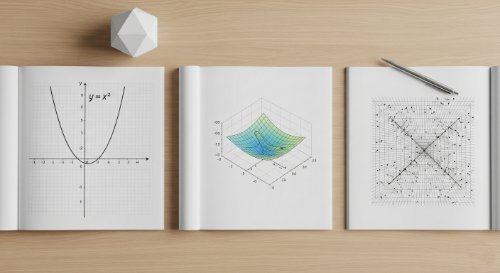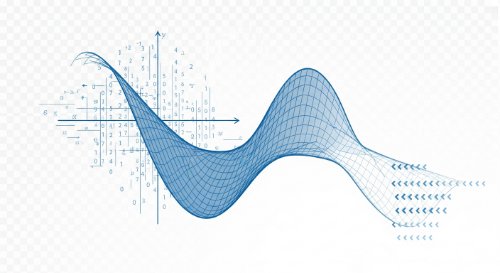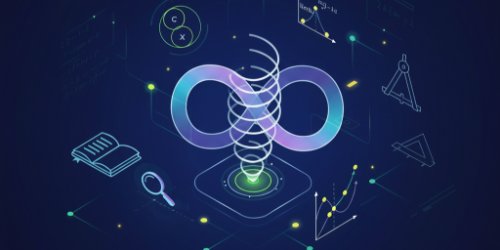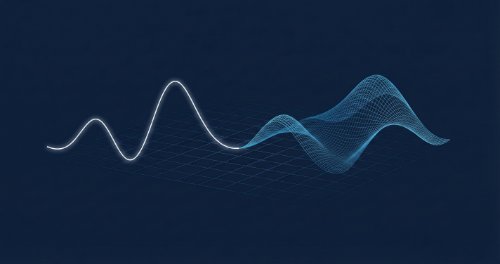Functions and Their Graphs - Single-Variable Calculus (Undergraduate Foundation)
105
7 hrs
 MTH 201: Mathematical Methods IThis learning track delivers the complete mathematical toolkit required for a university-level science, engineering, or computing degree. It systematically covers the entire MTH 201 curriculum, building from the foundational principles of single-variable calculus - functions, limits, continuity, and differentiability - to the advanced methods of multivariable calculus, infinite series, numerical methods, and ordinary differential equations. This is the definitive preparation for advanced quantitative study.
This programme is designed for second-year students offering MTH 201 at Obafemi Awolowo University, Ile-Ife, Nigeria. It is also helpful for any student in a STEM field - including physics, engineering, and computer science - who requires a rigorous and comprehensive command of calculus and its applications.
This track delivers a full skill set in mathematical analysis and applied problem-solving. Graduates will be able to solve a wide range of problems, from optimising multivariable functions to modelling dynamic systems with differential equations and testing the convergence of infinite series. This programme directly prepares students for success in advanced courses in vector calculus, partial differential equations, and real analysis, providing the necessary foundation for a career in engineering, data science, or theoretical physics.
MTH 201: Mathematical Methods IThis learning track delivers the complete mathematical toolkit required for a university-level science, engineering, or computing degree. It systematically covers the entire MTH 201 curriculum, building from the foundational principles of single-variable calculus - functions, limits, continuity, and differentiability - to the advanced methods of multivariable calculus, infinite series, numerical methods, and ordinary differential equations. This is the definitive preparation for advanced quantitative study.
This programme is designed for second-year students offering MTH 201 at Obafemi Awolowo University, Ile-Ife, Nigeria. It is also helpful for any student in a STEM field - including physics, engineering, and computer science - who requires a rigorous and comprehensive command of calculus and its applications.
This track delivers a full skill set in mathematical analysis and applied problem-solving. Graduates will be able to solve a wide range of problems, from optimising multivariable functions to modelling dynamic systems with differential equations and testing the convergence of infinite series. This programme directly prepares students for success in advanced courses in vector calculus, partial differential equations, and real analysis, providing the necessary foundation for a career in engineering, data science, or theoretical physics.
This learning track delivers the complete mathematical toolkit required for a university-level science, engineering, or computing degree. It systematically covers the entire MTH 201 curriculum, building from the foundational principles of single-variable calculus - functions, limits, continuity, and differentiability - to the advanced methods of multivariable calculus, infinite series, numerical methods, and ordinary differential equations. This is the definitive preparation for advanced quantitative study. This programme is designed for second-year students offering MTH 201 at Obafemi Awolowo University, Ile-Ife, Nigeria. It is also helpful for any student in a STEM field - including physics, engineering, and computer science - who requires a rigorous and comprehensive command of calculus and its applications. This track delivers a full skill set in mathematical analysis and applied problem-solving. Graduates will be able to solve a wide range of problems, from optimising multivariable functions to modelling dynamic systems with differential equations and testing the convergence of infinite series. This programme directly prepares students for success in advanced courses in vector calculus, partial differential equations, and real analysis, providing the necessary foundation for a career in engineering, data science, or theoretical physics.
 GET 209: Engineering Mathematics IMaster the mathematical language of engineering. This programme delivers the complete analytical toolkit required for a successful engineering career, covering single-variable calculus, multivariable calculus, linear algebra, and vector analysis. It provides the essential foundation for all subsequent engineering courses.
This programme is for second-year undergraduate students across all engineering disciplines. It delivers the official NUC CCMAS curriculum for Engineering Mathematics, providing the core training required for advanced modules in mechanics, thermodynamics, and circuit theory.
Model and analyse complex physical systems using calculus, linear algebra, and vector analysis. You will be equipped to solve problems in dynamics, statics, and field theory, providing the quantitative proficiency required for advanced engineering study and professional practice.
GET 209: Engineering Mathematics IMaster the mathematical language of engineering. This programme delivers the complete analytical toolkit required for a successful engineering career, covering single-variable calculus, multivariable calculus, linear algebra, and vector analysis. It provides the essential foundation for all subsequent engineering courses.
This programme is for second-year undergraduate students across all engineering disciplines. It delivers the official NUC CCMAS curriculum for Engineering Mathematics, providing the core training required for advanced modules in mechanics, thermodynamics, and circuit theory.
Model and analyse complex physical systems using calculus, linear algebra, and vector analysis. You will be equipped to solve problems in dynamics, statics, and field theory, providing the quantitative proficiency required for advanced engineering study and professional practice.
Master the mathematical language of engineering. This programme delivers the complete analytical toolkit required for a successful engineering career, covering single-variable calculus, multivariable calculus, linear algebra, and vector analysis. It provides the essential foundation for all subsequent engineering courses. This programme is for second-year undergraduate students across all engineering disciplines. It delivers the official NUC CCMAS curriculum for Engineering Mathematics, providing the core training required for advanced modules in mechanics, thermodynamics, and circuit theory. Model and analyse complex physical systems using calculus, linear algebra, and vector analysis. You will be equipped to solve problems in dynamics, statics, and field theory, providing the quantitative proficiency required for advanced engineering study and professional practice.
 MAT 223: Real AnalysisThis learning track provides the complete theoretical machinery of single-variable calculus and analysis. We build the subject from first principles, establishing the rigorous logical framework required for advanced quantitative disciplines. This is the 'why' behind the mathematics that powers science and engineering.
This track is built for second-year engineering and physical science students, particularly those at the University Of Ibadan. It is also structured for any student requiring the same rigorous theoretical foundation for advanced quantitative study.
On completion, you will command the complete theoretical basis of single-variable calculus. You will construct formal proofs, rigorously analyse function behaviour, and determine the convergence of infinite series. This programme provides the non-negotiable prerequisite knowledge for advanced study in differential equations, complex analysis, and theoretical physics.
MAT 223: Real AnalysisThis learning track provides the complete theoretical machinery of single-variable calculus and analysis. We build the subject from first principles, establishing the rigorous logical framework required for advanced quantitative disciplines. This is the 'why' behind the mathematics that powers science and engineering.
This track is built for second-year engineering and physical science students, particularly those at the University Of Ibadan. It is also structured for any student requiring the same rigorous theoretical foundation for advanced quantitative study.
On completion, you will command the complete theoretical basis of single-variable calculus. You will construct formal proofs, rigorously analyse function behaviour, and determine the convergence of infinite series. This programme provides the non-negotiable prerequisite knowledge for advanced study in differential equations, complex analysis, and theoretical physics.
This learning track provides the complete theoretical machinery of single-variable calculus and analysis. We build the subject from first principles, establishing the rigorous logical framework required for advanced quantitative disciplines. This is the 'why' behind the mathematics that powers science and engineering. This track is built for second-year engineering and physical science students, particularly those at the University Of Ibadan. It is also structured for any student requiring the same rigorous theoretical foundation for advanced quantitative study. On completion, you will command the complete theoretical basis of single-variable calculus. You will construct formal proofs, rigorously analyse function behaviour, and determine the convergence of infinite series. This programme provides the non-negotiable prerequisite knowledge for advanced study in differential equations, complex analysis, and theoretical physics.
 MTH 201: Mathematical Methods IMastering advanced calculus is essential for modelling complex systems in science and engineering. This track delivers the rigorous mathematical foundation demanded by the official NUC CCMAS curriculum for MTH 201. It systematically builds your expertise from fundamental single-variable theory to the sophisticated multivariable analysis used to solve critical problems in physics, economics, and technology.
This programme is for undergraduates in engineering, mathematics, physics, and computer science requiring a deep theoretical and practical command of calculus. It also serves economics students needing advanced quantitative tools or professionals in finance and data science seeking a solid mathematical base for technical research.
You will gain the analytical skills to construct formal proofs for differentiation rules and apply cornerstone theorems like Mean Value and Taylor's. You will master multivariable techniques, enabling you to solve constrained optimization problems with Lagrange multipliers and compute multiple integrals across line, surface, and volume domains. This track is the requisite preparation for advanced studies in differential equations, vector analysis, and complex engineering modelling.
MTH 201: Mathematical Methods IMastering advanced calculus is essential for modelling complex systems in science and engineering. This track delivers the rigorous mathematical foundation demanded by the official NUC CCMAS curriculum for MTH 201. It systematically builds your expertise from fundamental single-variable theory to the sophisticated multivariable analysis used to solve critical problems in physics, economics, and technology.
This programme is for undergraduates in engineering, mathematics, physics, and computer science requiring a deep theoretical and practical command of calculus. It also serves economics students needing advanced quantitative tools or professionals in finance and data science seeking a solid mathematical base for technical research.
You will gain the analytical skills to construct formal proofs for differentiation rules and apply cornerstone theorems like Mean Value and Taylor's. You will master multivariable techniques, enabling you to solve constrained optimization problems with Lagrange multipliers and compute multiple integrals across line, surface, and volume domains. This track is the requisite preparation for advanced studies in differential equations, vector analysis, and complex engineering modelling.
Mastering advanced calculus is essential for modelling complex systems in science and engineering. This track delivers the rigorous mathematical foundation demanded by the official NUC CCMAS curriculum for MTH 201. It systematically builds your expertise from fundamental single-variable theory to the sophisticated multivariable analysis used to solve critical problems in physics, economics, and technology. This programme is for undergraduates in engineering, mathematics, physics, and computer science requiring a deep theoretical and practical command of calculus. It also serves economics students needing advanced quantitative tools or professionals in finance and data science seeking a solid mathematical base for technical research. You will gain the analytical skills to construct formal proofs for differentiation rules and apply cornerstone theorems like Mean Value and Taylor's. You will master multivariable techniques, enabling you to solve constrained optimization problems with Lagrange multipliers and compute multiple integrals across line, surface, and volume domains. This track is the requisite preparation for advanced studies in differential equations, vector analysis, and complex engineering modelling.
Course Chapters
1. Introduction4
This chapter establishes the foundational concepts of the real number system. A command of these definitions is a prerequisite for defining and analysing the functions that form the core of this course. By the end of this chapter, you will be able to: differentiate between key number systems from natural to real; define and represent intervals on the real line; and correctly apply the mathematical concept of infinity.
Chapter lessons
1-1. Number Systems18:36
1-2. Rationals and irrationals26:08
2. Real-Valued Functions31
This chapter introduces the function - the central object of study in calculus. We will formally define what constitutes a real-valued function and establish the critical concepts of its valid inputs (domain) and possible outputs (range). By the end of this chapter, you will be able to: formally define a function; precisely calculate the domain for various real-valued functions; and understand the meaning and importance of a function's range.
Chapter lessons
3. Kinds of Real-Valued Functions5
This chapter moves from the general definition of a function to a systematic classification of key function families. We will identify and analyse the core algebraic types - including polynomial, rational, and piecewise functions - that form the basis of mathematical modelling across scientific disciplines. By the end of this chapter, you will be able to: classify functions as polynomial, rational, or algebraic; determine the natural domain for each of these types; interpret and analyse piecewise-defined functions; and test any function for symmetry.
Chapter lessons
3-1. Polynomials12:01
Meaning, domain and examples of polynomials.
3-2. Rational functions7:47
Meaning, domain and examples of rational functions.
3-3. Algebraic functions5:19
Meaning, domain and examples of algebraic functions.
3-4. Piecewise-defined functions16:00
Meaning, domain and examples of piecewise-defined functions.
3-5. Odd and even functions4:05
Meaning and examples of odd and even functions.
4. Transcendental Functions6
This chapter covers transcendental functions, the non-algebraic tools used to model natural phenomena like population growth, radioactive decay, and wave mechanics. We will systematically analyse the properties and graphs of exponential, logarithmic, trigonometric, and hyperbolic functions. By the end of this chapter, you will be able to: differentiate between algebraic and transcendental functions; analyse the domains and graphs of exponential, logarithmic, and trigonometric types; and define their corresponding inverse functions.
Chapter lessons
4-1. Meaning5:30
An introduction to transcendental functions.
4-2. Exponential and logarithmic functions17:17
Meaning, domain and examples of exponential and logarithmic functions.
4-3. Trigonometric functions21:24
Meaning, domain and examples of trigonometric functions.
4-4. Inverse trigonometric functions7:37
Meaning, domain and examples of inverse trigonometric functions.
4-5. Hyperbolic functions20:21
Meaning, domain and examples of hyperbolic functions.
4-6. Inverse hyperbolic functions19:37
Meaning, domain and examples of inverse hyperbolic functions.